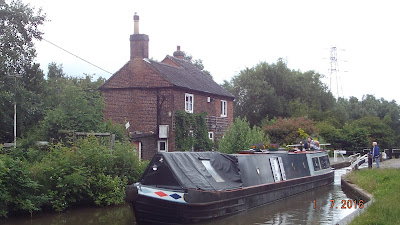On the North Oxford Canal July 2016
Day 22 Along the N.Oxford, mooring above Br.68 - 6.5 miles
Day 23 Almost to Braunston, mooring in the country - 7 miles and 3 locks
We continue our leisurely chug southwards. Today aiming for Rugby and Tesco's.
We moored with others on good shuttering after Clifton Cruisers by the golf course.
Next day, we arrived at Hillmorton and sorted out the water, toilet etc for long weekend moored up in the country.
Happily, moored in a good spot in deep, open water with good TV and WiFi. It's the Tour de France in the Pyrenees this weekend, plus Silverstone and Andy in the final at Wimbledon!
Heading into the 204yds (186m) Newbold Tunnel. This is the replacement tunnel put in during the improvements in 1834. It has 2-way working
Looking into the tunnel
Looking back - showing both towpaths (only one of which is operational)
Passing 'Empress' - an original 1898 FMC Steamer and always a working boat.
This more recent signage is of the spray paint technique.
When we arrived at the Hillmorton Locks, despite being paired (i.e. 2 narrow locks side by side) to speed up travel in the improvements of 1840), as one lock was in repair, only one of each pair was operational. Result - a queue!
This photo shows the replacement heel pin on the bottom of the top gate of Lock No.4
The strike plate on the cill
Lifting the gate back into position
All held by a single hook and eye!
Rather different paddle gear
Chris take the boat into the top lock, No.7.
See the robust stone steps and the paired lock beyond.
These locks are not that deep at 6'3" (1.90m)
We passes Nick and his fine 1936 Town Class large Woolwich
This photo tries to show the saplings recently cut back and the stone slab edging.
The angle of these slabs means it is not possible to moor against them without banging around. Boaters seek out the steel shuttering edges
An example of the saplings and shrubbery over taking the towpath edges - almost river like!
We moored outside Braunston, in the country. The opposite fields have the Medieval ridge and furrows, produced by simple ploughing to heap the soil up to form the ridge.
Their existence here shows this land has not been ploughed by modern machinery
This is the classic view arriving at Braunston, with the All Saints Church high on the hill.
As I write this, I can hear the Sunday morning church bells.
Yesterday, I walked into the village (25 minutes). All Saints Church stands proudly on elevated land, sacred from ancient days and the site of a Norman church and subsequent 14thC improvements - today's church is from around 1850. As Braunston grew in size as a result of the canal trade. It is know as the Cathedral of the Canals!
This effigy is memory of William, Fourth Baron Ros who died on a pilgrimage to the Holy Land in 1352
A windmill also stands on the hill - now without sails and a home
An interesting feature on show
There was a local wedding at the church. This is a 1910 gentleman's carriage waiting the Happy Couple!







































































